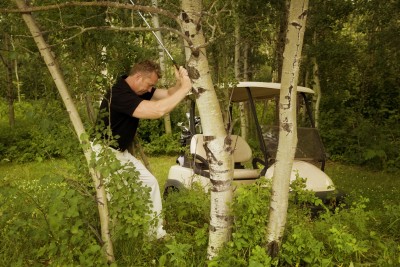 1) Not warming up properly – On competition days it’s always interesting to see how people approach the game. Some are there 2 hours early to warm up, hit the range, putting and chipping greens. Others are lacing up their shoes on the first tee 2 minutes before teeing off. Both approaches have their benefits, and a lot of it depends on your mentality towards the game.
1) Not warming up properly – On competition days it’s always interesting to see how people approach the game. Some are there 2 hours early to warm up, hit the range, putting and chipping greens. Others are lacing up their shoes on the first tee 2 minutes before teeing off. Both approaches have their benefits, and a lot of it depends on your mentality towards the game.
The benefit of turning up and teeing off is that you don’t have time to analyze your golf. You turn up and play with the swing you make up with; it’s a bit more pot luck to how you perform on the day. Taking the time to warm your body up and hit balls on the range and putt gets your body fully prepped for the competition. But it does allow your head to tell you about all the little tiny faults with your swing on the range or how you missed more putts to the left than to the right. I would always recommend turning up early and warming up fully. Just be confident in your swing, even if you made mistakes in the warm up. That’s exactly what it’s for!
2) Aiming at the flag – Sounds like a great idea really, aiming at the hole you’re trying to get the ball in. But, more often than not it’s not the best place to be aiming. Think about where the danger is. Is there a lake guarding the front of the green? Are there 3 bunkers to the left and one to the right? Weigh up the potential hazards and their severity and decide the spot with the biggest margin for error. Aim for that instead of the flag. It might feel strange aiming at the edge of the green when the flag is in the middle, but it allows you some breathing room should you make a mistake.
3) Choosing the hero shot – Something we are all guilty of from time to time, and if you’re playing for fun why not go for it. If you’re keeping a scorecard or playing in a competition, just keep your head together and play sensibly. It can be extremely tempting to go for glory and try for that par 4 green in 1 or par 5 in 2, but more often than not it will probably leave you in a heap of trouble and regretting your decision. Remember: the hero in the clubhouse after the competition is the one who held it together for 18 holes, not the guy who made a brilliant eagle with a miracle shot followed by 3 triple bogeys when he tried to replicate things.
4) Convince themselves they are playing badly – I was guilty of this on Sunday. I was playing a new course, and was playing well tee to green but missing loads of putts. The more this went on the more frustrated I got and the more I kept telling myself “I just can’t putt today”. Even when I got used to the greens a bit and started to putt a bit better, I was still telling myself “I can’t hole a putt today”. If you keep telling yourself something, you will convince yourself it’s true. Keep this kind of thinking at bay by treating each shot as an individual event.
5) Playing the wrong club – The most common mistake many new golfers make is to use too little club. This can lead to a few problems. Lots of holes will have most of their hazards in front of the green, so by under-clubbing you bring those right into play. Take a trip to the practice ground and hit each club until you discover an average distance for each. Then next time you play, use the technique in 2 and hopefully you should be getting closer to the flag and away from dangers.
6) Skipping the pre-shot routine – When things start to go wrong, it can be easy to start skipping your pre-shot routine. When things are getting a little wayward that’s really when you need your pre-shot routine, so stick to it! Doing the same ritual before each shot can help you to focus and really feel the shot. It also gives you time to cool off and gather yourself after a bad shot.
7) Not coping in windy conditions – It’s not just the rain (see previous post on coping in the rain) that affects how the course plays. The wind can play a big part in club selection and shot selection. Always check the wind strength and direction by throwing a few blades of grass in the air.
Take a look around you. Are you surrounded by trees? High up or in a valley? These will affect how the wind feels to you. A common misconception is that hitting harder into the wind will make up the distance. The harder you hit, the more backspin you will put on the ball, which will make the ball “climb up” the wind and travel less distance. When playing into the wind, take extra club not extra power.
Happy golfing!